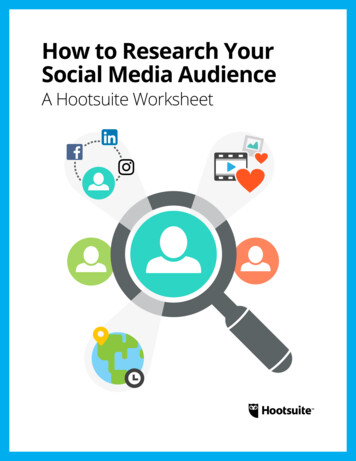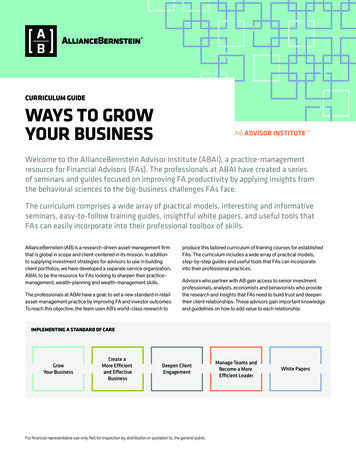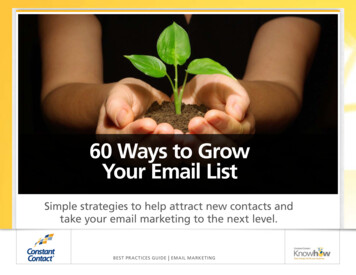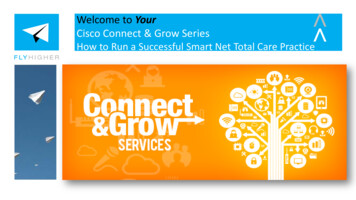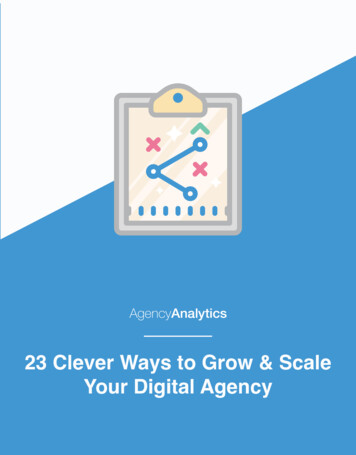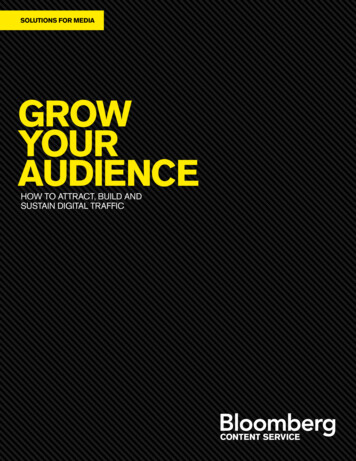
Transcription
SOLUTIONS FOR MEDIAGROWYOURAUDIENCEHOW TO ATTRACT, BUILD ANDSUSTAIN DIGITAL TRAFFICbloomberg.com/content-service
SOLUTIONS FOR MEDIACOMMANDING AN AUDIENCEDriving online traffic is one of the most difficult and persistent challenges faced by publishers, broadcastersand media companies. The digital ecosystem is constantly expanding, with more and more publisherscompeting for larger and larger audiences every day.This growth dynamic creates an unprecedented potential upside. No matter what kinds of content publishersprovide, an audience for it is almost certainly out there. The challenge: finding them in a sea of possibilities,attracting other like-minded people and building the audience steadily over time. Publishers that candemonstrate a reliable and growing audience will be able to monetize this traffic, creating additional resourcesthat can be reinvested in audience development.To reach this ultimate goal, publishers first need to find and then deploy the right tactics. This white papercovers many of the most popular approaches, so publishers can make informed choices, find what works,evaluate results accurately and develop a sustainable and enterprise-wide strategy for building and growinga digital IA3PARTNERSHIPSAND nt-service2
SOLUTIONS FOR MEDIATARGETINGSEARCHENGINESSearch engine optimization (SEO) is one of the mostwell-known ways to help audiences around the worldfind their way to the content on a publisher’s site.SEO involves tailoring a site’s structure and contentto ensure that the page is listed earlier and morefrequently in search engine results.“Of course publishers want to be the first site to publisha story,” the global head of marketing said. “But they canalso optimize SEO by adding substantial new content toa story as it evolves. If the time stamp changes often andthe additional content is meaningful, search engines willboost the story’s ranking.”Volume, relevance and qualityAccording to the global head of marketing and salesoperations at a major media company, content volumeis the top factor affecting SEO.Publishers can also attain relevance by providing“long-tail” content or evergreen articles that arecomprehensive enough and updated often enoughto become a top result returned for a specific topic,category or search term.“The more content publishers produce, the easier itis to ensure high rankings,” she said. “More contentmeans search engines are crawling more of yourpages. Adding volume is the number one thing anypublisher can do to make sure they are driving asmuch traffic as possible to the site.”While volume is vital, the quality and relevance ofcontent must remain high. Search engines aredesigned to detect shortcuts, such as duplicatecontent, when scraping pages. Sites that attemptto increase page volume with low-quality contentwill be penalized.Relevance refers to the timeliness of a story, thuspublishers can drive traffic by being the first tocover a story, update the story with new contentmore frequently—or both.Social sharingWhile publishers will be hard-pressed to makecontent “go viral,” content that generates more activityon social media will achieve better search engineresults. Although the effect of social sharing on searchalgorithms is not completely known, social sharing doesplay an important role according to a social media editorat a large news organization.“Shares, likes and retweets are very influential, althoughsearch engines do not publish specifics,” she said.“That’s why it’s important for publishers to publishcontent that is both social media–friendly and includesembedded links to the original story or related content.”Embedded links not only improve search engine results,they help publishers convert fleeting social traffic intoregular site visitors when stories, videos or other contentare shared widely.bloomberg.com/content-service3
SOLUTIONS FOR MEDIATARGETINGSEARCH ENGINESMetadata and keywordsAt an even more granular level, publishers can fine-tunethe metadata of published content to improve SEO.Metadata is the data embedded in content that formallydescribes its structure and the nature of its content.Implementing proper metadata is not complex as longas publishers follow best practices. Some of the basicsare editing the five standard metatags in the head section of a page (title, type, description, image andURL) as well as keeping the tags short (70 charactersfor titles, 150 characters for descriptions). It is also agood idea to place keywords closer to the beginningof the tag. Publishers will want to avoid pages withduplicate metadata content, which can hamperrankings. For additional ideas, the site schema.orgprovides templates publishers can use to buildpages in ways that improve search results withBing, Google, Yahoo and others.The real challenge with metadata is keeping it fresh,monitoring, reviewing and refining metadata regularly.When Google updates its search algorithm, for example,the company is changing what its search bots look forand what they deem relevant. Publishers need to reactquickly to avoid the risk of hard-earned search rankingsfalling overnight.As always, producing a steady stream of high-qualitycontent is the top priority. Publishers that ensure thatprimary and section front pages feature appropriatelytagged timely, relevant content will be better-positionedto adapt when search parameters change.Appropriate tagging of content requires publishersto choose keywords that reflect how an audiencesearches for content. Keyword research can help inthis regard. Publishers can use free research tools,such as Google Adwords Keyword Planner, GoogleAnalytics and the Google autocomplete function, orchoose to use paid tools.“Getting a sense of the volume of searches forcertain topics allows publishers to retrofit contentmetadata in order to drive traffic,” the global headof marketing said. “If you know the demand for yourcontent is out there, keyword research lets youmake sure the audience can find it.”One new trend, the social media editor notes, isthe concept of differentiating keywords for SEOfrom those used on social media.“Social keywords are those terms that may appear inposts on social media, as well as those the audience isusing to search for content on social media platforms,”she said. “Conventional search engine keywords tendto be literal. Social keywords are more conversational.If a publisher is trying to reach multitasking moms withsocial media content, for example, the best keywordsto use might be ‘laundry’ or ‘carpool.’ It’s important tobe aware of the nuances in each channel.”This is the point at which SEO blends into social mediastrategy, which is the second tactic publishers can useto attract more traffic.bloomberg.com/content-service4
SOLUTIONS FOR MEDIACHANELINGSOCIALMEDIANot coincidentally, developing a robust social mediastrategy is critical for building and growing an onlineaudience. While managing social media can be moreinvolved than optimizing SEO, it can potentially paybigger benefits. What publishers need to keep in mindis a simple three-part process.1. Select the right networkMany publishers understand that each social networkhas its own “personality,” which affects the type ofaudience it attracts. Facebook is driven by sharedarticles and videos. LinkedIn appeals to a moreprofessional audience. If photos are a key offering,Instagram will be important. If video content isfrequent, YouTube will be a natural fit. In general,publishers need to think about the type of contentthey want to share and align it with the strengthsof these platforms (see illustration on thefollowing page).“It really depends on who the target audience is, thestrengths of the publisher’s content and identifying asocial media network that fits both,” the social mediaeditor said. “It also depends on the publisher’s goals.For example, the LinkedIn influencer program canhelp individuals develop large followings, which isideal for building brand equity. But LinkedIn doesnot produce the same levels of referral traffic asother networks, which may not fit with a pureaudience-development strategy.”Additional considerations include which networks aremost popular in the local area or region (publishers candiscover these using social media analytics) and howthe target audience prefers to engage with contentonline. Again, analytics can help publishers determinewhether a featured article will garner more views andshares if it is longer or shorter, includes video or notor is distributed at a certain time through one or moresocial media channels.bloomberg.com/content-service5
SOLUTIONS FOR MEDIACHANNELING SOCIAL MEDIA:HOW SOCIAL ARE YOU?Knowing the advantages of social mediaplatforms can help publishers choose theright channels for building an audience.BiggestaudienceDriven bycontentsharing1 or videoUsergeneratedcontent1 billionusers236 millionusersOwned sPublisherYoungestaudience300 d byFacebook364 berg.com/content-service6
SOLUTIONS FOR MEDIACHANNELINGSOCIAL MEDIA2. Build an audienceWith a basic social media strategy in place, publisherscan focus on building a core audience. The primaryconcern should be publishing as much high-qualitycontent as possible, not building or promoting thepublisher’s brand. In a fractured media landscape,the average member of the audience cares moreabout what she is experiencing than where itoriginated online. In addition, “high-quality content”means more than a well-written story or well-producedvideo segment. It means content that is framedspecifically for social media.“Social media can’t be an afterthought,” the socialmedia editor said. “It needs to be integrated into thepublisher’s strategy. It should be part of the pitchprocess for stories, so all stakeholders can weigh inabout how a certain story should be promoted andhow to amplify that promotion with other channels.”Visuals are essential for social media content.Pairing fresh content with a compelling photo ora perfect thumbnail image can make a significantdifference in traffic.“Last year, Twitter made tweets with photos appearautomatically,” she said. “As a result, every tweet witha photo gets three times the real estate of tweetswithout photos. And these tweets perform twice aswell as those without a visual component. The samedynamic holds true on Facebook. Publishers need toselect visuals as carefully as they do the content.”Beyond visuals, publishers need to think about thetiming of scheduled social content. Most sites publishnew content on the hour, making it easier for newcontent to get lost. Publishers may want to experimentwith off-times, such as 8:07 instead of 8:00, in an effortto stand out.Paid efforts can also produce valuable traffic gains.These include sponsored updates on LinkedIn,promoted tweets and Facebook ads. In fact, Facebookoffers some of the most sophisticated options forpaid traffic, giving smaller publishers the ability totarget specific influencers or pay for a certain thresholdof likes. While this is not a sustainable strategy, it canhelp publishers create a solid platform for increasingtraffic organically.Audience engagement is a critical component ofaudience building. Examples include rewards for socialsharing, such as a contest or giveaway that requiresreaders to like or follow the publisher’s brand to enter.Then publishers can use social media analytics, suchas those from Simply Measured, Top Feed andSysomos, to see which engagement tactics resultin more social sharing.It is important for publishersto understand the dynamics ofengagement and how they vary bychannel. More is not always better,the social media editor noted.“Fewer retweets by verified Twitter accounts are muchmore valuable than more retweets from those withfewer followers,” she said. “All metrics matter, and thenumbers will vary relative to the size of the publisher.But they should have a strong grasp of the differencebetween the total size of the audience, the rate ofengagement and the rate of actual shares.”bloomberg.com/content-service7
SOLUTIONS FOR MEDIACHANNELINGSOCIAL MEDIA3. Feed the audienceWith a core audience in place on social media,publishers need to continue to cultivate that audiencewith the content they want most.One way is to establish a regular content “feedingschedule” and use that content to extend the conceptof engagement to two-way “conversations.”Publishers can produce social content that asks aquestion, solicits feedback or requests user-generatedcontent (UGC), then include a simple call to action,such as “RT if you agree” or “share this with yourfriends” or “post a comment below.”“Two-way engagement gives the audience a strongsense of validation,” the social media editor said.“As long as the content matches the audience’sexpectations for tone, and the publisher is responsiveto what audiences provide, these techniques can resultin a wider-reaching conversation that can draw in newaudience members.”Developing exclusive content for social media is anotherway to feed the audience. Instead of repurposingexisting content for social channels, publishers candevelop unique stories or videos that are the exclusivedomain of the social audience. To be effective,publishers have to build up enough staff to maintaina 24/7 presence. Alternatively, publishers can useservices such as HootSuite or WhoSay to scheduleposts in advance and use analytics to discover whensocial content performs best with the target audience.As long as the content matchesthe audience’s expectations fortone, and the publisher is responsiveto what audiences provide, thesetechniques can result in a widerreaching conversation that candraw in new audience members.bloomberg.com/content-service8
SOLUTIONS
For example, the LinkedIn influencer program can help individuals develop large followings, which is ideal for building brand equity. But LinkedIn does not produce the same levels of referral traffic as other networks, which may not fit with a pure audience-development strategy.” Additional considerations include which networks are most popular in the local area or region (publishers can .

